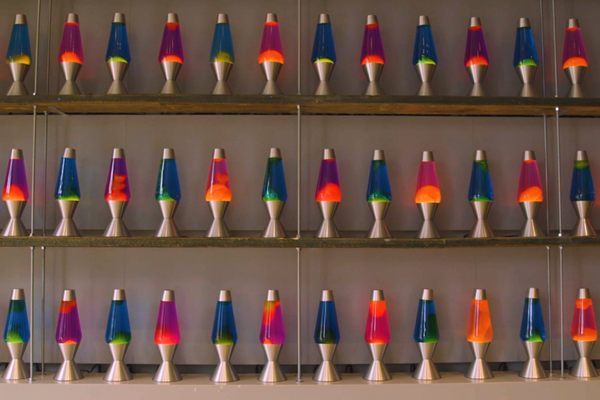How Mumbai’s Dabbawalas Deliver 200,000 Homemade Meals a Day
The city’s food delivery people run an impressive relay race, which relies heavily on the local railway network.

At 9:10 a.m., Nilesh Shankar Bachche picks up the dabba (lunchbox) labeled “B 5 W 6N2” from an apartment building in Borivali West, a neighborhood in Mumbai, India. Inside the dabba, or tiffin, lies three to four stackable cylindrical compartments. One compartment will typically contain rice or rotis. Another might hold dal or a curry, then vegetables, yogurt, or dessert. In this one, there are four compartments: one with a yellow dal, one with long-grain Basmati rice, another with bhindi masala (Indian spiced okra), and the last with fluffy rotis and a tiny box of jaggery—an unprocessed precipitate from sugar cane juice—for dessert.
Bachche is a dabbawala, a term meaning “lunchbox person,” and has been collecting meals since 8:30 a.m. this morning. On average, he collects 20 to 25 such dabbas in a day. He and an army of close to 5,000 others are employed by the Nutan Mumbai Tiffin Box Suppliers Trust, a cooperative ensuring that 200,000 office workers and college students receive hot meals—each typically cooked at the recipient’s home—to their doorstep, five to six days a week.
The dabba system, as we know it today, officially started in 1890, when Mumbai was still known as Bombay, and India was a part of the British Raj. The British built extensive railway and road networks over the archipelago of Bombay for the purposes of streamlining exports out of India. Back then, Bombay thrived as the country’s trade hub, and Indians from each corner of the country flocked there to work. With the opening of the Great Indian Peninsula Railway in 1853 as well as the establishment of Bombay’s first cotton mill in 1854 and the University of Bombay in 1857, jobs were plenty and Bombay was more than just a big city; it was on its way to becoming a metropolis.

By 1891, Bombay’s population had reached nearly 820,000 people. Parsis, Hindus, Muslims, Christians, Jews, and Jains worked side by side as merchants, lawyers, engineers, doctors, railway construction and dock workers. Each community developed their own distinctive cuisine, informed by both their heritage and this cultural exchange. Hindu fare from Gujarat, for example, was starkly different from the local Maharashtrian Hindu fare. Gujarati fare is always sweet and largely vegetarian, but Bombay, being a port, is hugely partial to seafood.
Legend has it that the system has its roots in the late 1800s when a Parsi banker hired a Maratha worker to pick up the banker’s homemade lunch from his house, then deliver it to his office four miles away. Mahadeo Havaji Bacche, the delivery man, was one of many men parked at a nearby intersection wearing topis, or caps, and ready to work odd jobs. But Bacche saw this one-off as an untapped opportunity to provide home-cooked meals for office workers around Bombay; in 1890, he hired 100 Maratha workers to join him in making it a reality.
While in those days, dabbas were made at home, by either a wife or a housekeeper, today dabbas are sourced from a multitude of places. In addition to foods cooked at home typically by a mother, grandmother, aunt, or wife, dabbawalas also have connections with several kitchens that specialize in home cooking, many employing a woman-driven workforce, including widows and underprivileged women, in an effort to encourage them to support themselves independently.

Present-day Mumbai has a population of 18.4 million people. But gridlock traffic—with roughly 265 cars per mile—doesn’t get in the way of dabbawalas, who deliver 200,000 lunches per day with near-perfect accuracy. Instead, they rely on the world’s busiest railway network to pick-up and deliver lunch to their intended eaters.
The individual label on each dabba is crucial to ensuring it gets to where it needs to go. Since dabbas change hands multiple times, with different people picking up, sorting, transporting, and delivering them, each one is assigned a string of numbers and letters, not unlike a postcode. According to Bachche, in the case of B 5 W 6N2, the “B” and the “W” stand for Borivali West, its origin. The 6N2 denotes the destination: The “6” refers to the locality for delivery, “N” represents the building where it’s to be delivered, and “2” is for the floor number. The “5” refers to the destination station, in this case Churchgate Station. This code works to streamline this daily relay race, and ensures a startlingly consistent and on-time delivery rate. The system is so reliable, it bears a 99.9999 percent accuracy rate. That’s one goof for every 16 million deliveries.
Bachche, like most dabbawalas, got into the dabba system through a friend. Bachche hails from near Pune, a city southeast of Mumbai, which is where the majority of dabbawalas come from. In the past, most dabbawalas came from farming communities and entered the city and the dabba system out of economic necessity. Today, however, it isn’t the pay that attracts men like Bachche, who makes 15,000 rupees per month (a little over 200 U.S. dollars), but the work itself. “We get to feed people food on a daily basis,” he says in a mixture of Marathi and Hindi. “There’s no other job like this one—people need their food to live and to work, and work well.”

The recipient of this particular dabba, “B 5 W 6N2,” works in the stock market. He’s left home by 7:15 a.m. to reach his job in Fort, a neighborhood 25 miles away from his house in Borivali, by 9:00 a.m. Like most office workers in Mumbai, he too takes the train, but can’t carry his dabba with him because of the crowds. At 10:15 a.m., the dabba arrives by bicycle at Borivali Station. From there, it moves on to Andheri Station, a pivotal hub in the locality of West Mumbai. At Andheri, it gets placed in one of several batches, depending on where the dabbas’ destination stations are.
After being placed into the appropriate groupings, the dabbas are loaded onto crates, which are each balanced on a dabbawala’s head (sometimes it’s a two-person job) and raced to the platform. Each crate contains around 40 dabbas and weighs roughly 130 pounds. Then, in less than 40 seconds, the crates are loaded into the luggage compartment of the destination train, and off they go.
Once the crates reach their respective stations, another set of dabbawalas takes over their transport and delivery. By 12:15 p.m., the crates traveling to Fort are offloaded at Churchgate Station, and dabba “B 5 W 6N2” is among them. It makes off with other dabbas headed for the Fort area by bicycle, though some dabba deliveries happen by foot, and others by cart. In midday traffic in this part of the city, cycle is the most efficient way to get around because standard traffic laws, including stopping at lights, don’t apply to cyclists.
At 12:50 p.m. sharp, “B 5 W 6N2” reaches the stock market and the hands of its hungry recipient.

While the dabba system might seem antiquated, it’s arguably much more effective, in terms of accuracy and on-time delivery, than its modern-day counterparts. Despite the ongoing popularity of delivery apps, such as Swiggy and Scootsy, Bachche gets a handful of new customers every month or two. The distinguishing feature with dabbas, he notes, is the fact that he delivers home-cooked food, for which there is no compromise.
Once lunch is over, the same relay is carried out—this time in reverse. The now-empty “B 5 W 6N2” dabba is picked up, sorted at Churchgate station, transported, and dropped back home again in Borivali. All this happens for a price of a mere 1,200 rupees (around 15 U.S. dollars) per month.
While there have been attempts to recreate the dabba delivery system elsewhere in India, notably Bengaluru and New Delhi, the need and the scale of these other systems is in no way comparable to the original. Moreover, since these are comparatively less congested cities, the use of the rail network isn’t a necessity, since most office workers in New Delhi and Bengaluru travel by auto-rickshaws, buses, metros, and car, over shorter distances.
By the time dabba “B 5 W 6N2” is delivered home, then washed, dried, and ready for another pick-up the following morning, it’s nearing six in the evening. With his shift over, Bachche goes straight home and, in his own words, is “in bed by ten to do another rewarding day’s work the next morning.” It’s a work-heavy life, but, Bachche says, excitedly, “[I] wouldn’t have it any other way.”
Gastro Obscura covers the world’s most wondrous food and drink.
Sign up for our email, delivered twice a week.





























Follow us on Twitter to get the latest on the world's hidden wonders.
Like us on Facebook to get the latest on the world's hidden wonders.
Follow us on Twitter Like us on Facebook